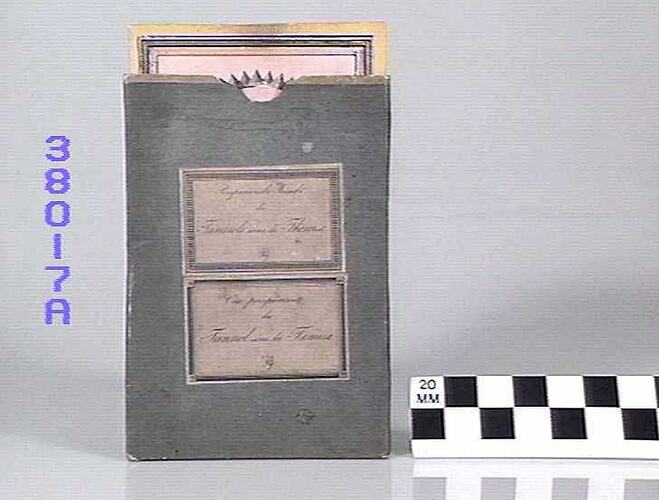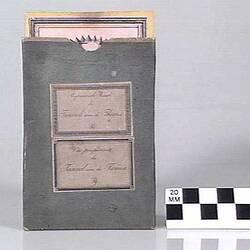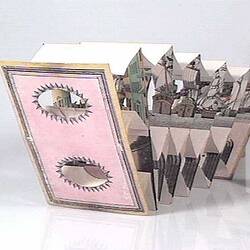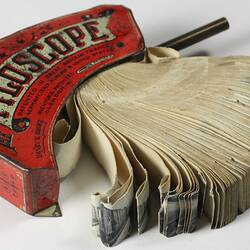Summary
German peepshow in its original slip case consisting of six panels which have been attached in a concertina like arrangement. Its two viewing peeps give views above and below the water line. The top view shows numerous ships on the Thames, whilst the lower view depicts pedestrians, carriages and horsemen within the Thames Tunnel.
The Thames Tunnel, designed by Marc Brunel (Father of Isambard Kingdom Brunel) was built between 1825-1843. When finally opened it was described as the 'eighth wonder of the world' and produced a flurry of spectator interest. While the tunnel had initially been built to allow for the movement of cargo by horse and cart, the long construction time meant that money ran short and in the end only pedestrian traffic was catered for.
A peepshow is a closed, or partially closed box with one or more viewing holes. Interchangeable images are placed within the box for viewing. There were basically two types of peepshow boxes produced. Horizontal boxes had their viewing holes at one end, and relied on the lens of the viewer and depth of the box to create perspective. Vertical boxes (boite d'optiques) also used the lens of the viewer, but in combination with an angled mirror to redirect the gaze, or to create an illusion.
Peepshows have their origin in the study of perspective during the 15th and 16th centuries. Whilst originally the preserve of the educated, scientists and artists, by the 18th century peepshows had become a feature of popular street entertainment. Itinerant showmen travelled the towns and fairs, attracting people by the use of their voices, musical instruments and sometimes an accompanist. The mysterious and magical peepshow was but part of the total show which relied strongly on the showman's story telling abilities. The showman would also at times create movement by manipulating the images within by use of strings and hooks. Some types of images allowed the viewer to see the picture as by day, and then as by night through the use of back-lighting, provided by the sun or a candle. Popular themes for the peepshows included foreign countries, historical events and nature. Small, domestic versions of the peepshow were also produced. During the 19th century peepshows were also sold as sourvenirs. These could be as diverse as alabaster peep eggs, to sheets of paper pasted together to form a concertina shaped perspective view of a scene. Peepshows were popular in many parts of the world and went under several different names: in England and the U.S.A., peepshow; in France, boite d'optique; in Italy, mondo nuovo, in Holland, optiques; in Germany, guckkasten. They were also popular in China and Japan.
This peepshow is part of the Francis Collection of pre-cinematic apparatus and ephemera, acquired by the Australian and Victorian Governments in 1975. David Francis was the curator of the National Film and Sound Archive of the British Film Institute as well as being a co-founder of the Museum of the Moving Image in London, which was operational between 1988 and 1999.
Description of Content
Peepshow showing different views of the Thames Tunnel. The two viewing peeps give views above and below the water line. The top view shows numerous ships on the Thames, whilst the lower view depicts pedestrians, carriages and horsemen within the Thames Tunnel.
Physical Description
Cover of heavy card, with pasted on pink/red covering with black border. Two black bordered oval peeps have been cut out of the cover. Peepshow has six concertinad panels, with multi-coloured images.
More Information
-
Collection Names
-
Collecting Areas
-
Acquisition Information
Loan & Subsequent Donation from Australian Film Institute (AFI), Mr David Francis, by Nov 1990
-
Place & Date Manufactured
-
Collector
-
Place & Date Depicted
-
Format
Peepshow, Colourised
-
Inscriptions
On slip case: Top label: 'Perspectivische Ansicht/des/Tunnels unter der Themse/ MB (?)' Bottom label: 'Vue perspective/du/Tunnel sous la Tamise/MB (?)'
-
Classification
-
Category
-
Discipline
-
Type of item
-
Overall Dimensions - Closed
148 mm (Width), 6 mm (Depth), 222 mm (Height)
-
References
The Richard Balzer Collection - Peepshows [Link 1] Accessed 18 June 2010 The Thames Tunnel [Link 2] Accessed 25 June 2010
[Book] Balzer, Richard. 1998. Peepshows: A Visual History., 1998, 10-43 Pages
-
Keywords
Commemorations, Optical Toys, Peepshows, Perspective Views, Souvenirs



